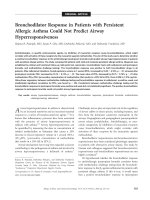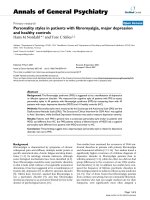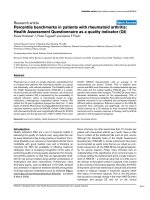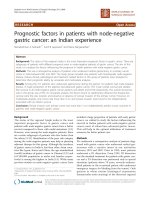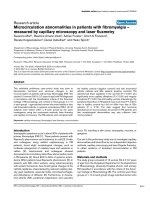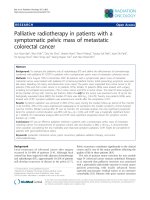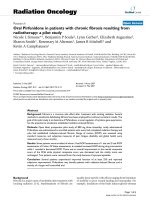Báo cáo y học: "Percutaneous tracheostomy in patients with severe liver disease and a high incidence of refractory coagulopathy: a prospective trial" doc
Bạn đang xem bản rút gọn của tài liệu. Xem và tải ngay bản đầy đủ của tài liệu tại đây (230.11 KB, 7 trang )
Open Access
Available online />Page 1 of 7
(page number not for citation purposes)
Vol 11 No 5
Research
Percutaneous tracheostomy in patients with severe liver disease
and a high incidence of refractory coagulopathy: a prospective
trial
Georg Auzinger, Gerry P O'Callaghan, William Bernal, Elizabeth Sizer and Julia A Wendon
Institute of Liver Studies, Liver Intensive Care Unit, King's College Hospital, Denmark Hill, London SE5 9RS, UK
Corresponding author: Georg Auzinger,
Received: 12 Apr 2007 Revisions requested: 31 May 2007 Revisions received: 10 Aug 2007 Accepted: 8 Oct 2007 Published: 8 Oct 2007
Critical Care 2007, 11:R110 (doi:10.1186/cc6143)
This article is online at: />© 2007 Auzinger et al.; licensee BioMed Central Ltd.
This is an open access article distributed under the terms of the Creative Commons Attribution License ( />),
which permits unrestricted use, distribution, and reproduction in any medium, provided the original work is properly cited.
Abstract
Introduction The purpose of this study was to assess the safety
of percutaneous dilational tracheostomy (PDT) performed by
experienced operators in critically ill patients with liver disease
and coagulopathy.
Methods We conducted a prospective cohort study in a 10-bed
specialist liver intensive care unit of a tertiary university teaching
hospital. The study consisted of 60 consecutive patients in need
of tracheostomy insertion. Patients were categorized as having
refractory coagulopathy if their platelet count was less than or
equal to 50 × 10
9
cells/L or their international normalized ratio
(INR) was greater than 1.5 on the day of PDT and for the 72
hours afterward despite clotting support.
Results Twenty-five patients fulfilled the definition criteria of
refractory coagulopathy. There was no significant difference in
the number of adverse incidents between groups. Only one
patient in the coagulopathy group had a severe bleeding
complication, but this did not require open surgical intervention.
The rate of clinically relevant early complications in all patients
was not higher than expected (n = 7, 12%). Resource utilisation
was higher for patients with coagulopathy who received
significantly more platelet transfusions over the 3-day period (80
versus 49 units; p = 0.009) and who demonstrated a trend
toward increased fresh frozen plasma requirements (p = 0.059).
The number of patients requiring platelet transfusion was higher
in the coagulopathy group (21/25 versus 20/35; p = 0.029).
Hospital survival did not differ between groups.
Conclusion PDT is safe and not contraindicated in patients with
severe liver disease and refractory coagulopathy.
Introduction
Since the introduction of guidewire-assisted percutaneous
dilational tracheostomy (PDT) into routine clinical practice
some 20 years ago by Ciaglia and colleagues [1], the tech-
nique or modifications thereof have been used increasingly in
intensive care units (ICUs) worldwide. In fact, the procedure
has replaced surgical tracheostomy in many ICUs given the
ease and speed of application, lack of need for transfer to the
operating theatre, and a comparable (if not better) safety pro-
file [2]. With increasing familiarity with the procedure, indica-
tions for PDT have been extended to include patients with
previously defined contraindications, such as unfavourable
anatomy due to obesity or short neck [3], inability to extend the
neck, and coagulopathy or use of anticoagulants [3,4].
Refractory coagulopathy and thrombocytopenia or impaired
coagulation is frequently seen in patients with liver disease
requiring ICU admission. A comprehensive, prospective risk
assessment of PDT in this patient population has not been
performed thus far. We report the results of a prospective
study on the safety of PDT in patients with a wide range of liver
disease, or following liver transplantation for acute liver failure,
in which the incidence of refractory coagulopathy is high.
Materials and methods
Patients
Over a consecutive 7-month period, all patients requiring PDT
in a 10-bed specialist liver ICU were enrolled in the study. The
indication for tracheostomy was made by the consultant in
EVLWI = extravascular lung water index; FFP = fresh frozen plasma; ICU = intensive care unit; INR = international normalized ratio; ITBVI = intratho-
racic blood volume index; MAP = mean arterial pressure; PDT = percutaneous dilational tracheostomy; SOFA = Sepsis-related Organ Failure
Assessment.
Critical Care Vol 11 No 5 Auzinger et al.
Page 2 of 7
(page number not for citation purposes)
charge of the ICU at the time. The procedure was carried out
within 24 hours after the decision to perform PDT was made,
regardless of the degree of coagulopathy and with clotting sup-
port as clinically indicated. No surgical tracheostomies were
performed during the study period and no patients were
excluded. Tracheostomies were performed at the bedside by
experienced operators (at least 75 PDTs performed). The pro-
cedure was undertaken by one of two consultants and/or a sin-
gle senior ICU trainee under consultant supervision. Informed
consent from the patient's next of kin was obtained to undertake
the percutaneous tracheostomy, and subsequently consent for
the study was obtained. The study was approved by the local
research ethics committee.
Bronchoscopic guidance was not routinely used. All patients
received anaesthesia with propofol, midazolam, or lorazepam.
Analgesia with fentanyl was administered to all but four patients.
Atracurium or vecuronium was used for muscle relaxation. FiO
2
(fraction of inspired oxygen) was increased to 1.0 and ventilator
settings were kept unchanged, apart from patients on pressure
support ventilation in which a controlled mode of ventilation,
flow or pressure-limited, was initiated for the period of the inter-
vention and maintained until reversal of paralysis. Continuous
heart rate monitoring, arterial oxygen saturation measurement,
end tidal CO
2
, and invasive arterial blood pressure monitoring
were performed in all patients. Resuscitation and difficult airway
equipment was present at the bedside.
Oxygenation and cardiovascular status, including use of ino-
tropic or vasopressor support, was recorded prior to, during,
and for a 48-hour period following the procedure. Twenty-four
patients had advanced haemodynamic monitoring in place
(transpulmonary thermodilution and pulse contour cardiac out-
put monitoring via the PiCCO system; PULSION Medical Sys-
tems AG, Munich, Germany). In the latter group, volumetric
preload markers (intrathoracic blood volume index, or ITBVI)
and extravascular lung water index (EVLWI) were calculated.
Sixty patients underwent PDT during the study period. Forty-
threetracheostomies were performed using the 'Blue Rhino' sin-
gle-dilator technique (Cook Medical Inc., Bloomington, IN,
USA). In the remaining 18 patients, the sequential dilation tech-
nique was used (Ciaglia Percutaneous Tracheostomy Intro-
ducer Set; Cook Medical Inc.). The procedure was performed
as previously described [5,6].
Definition of refractory coagulopathy and complications
Refractory coagulopathy was defined as a platelet count of less
than 50 × 10
9
cells/L or an international normalized ratio (INR)
of greater than or equal to 1.5 or a combination of both on the
day of PDT and over the consecutive 3 days following PDT
despite platelet transfusion and fresh frozen plasma (FFP) sup-
port. Patients were then defined as group 1 (refractory coagu-
lopathy) or group 2 (mild or no coagulopathy).
The amount of platelet transfusions and FFP administered
immediately before and during the 72-hour period following
PDT was recorded. FFP and platelets were transfused in an
attempt to raise the platelet count to greater than 70 × 10
9
cells/L and lower the INR to less than 1.5 prior to surgery.
Standard doses of FFP (12 to 15 mL/kg) and platelets (1 unit of
donor pooled platelets expected to raise the platelet count by
20 to 30 × 10
9
cells/L) were administered. INR and platelet
thresholds were less stringent in the 72-hour period following
PDT and were corrected as clinically appropriate.
Complications were defined as potentially life-threatening,
severe, or minor and were further classified into early or late.
Early complications referred to all immediate procedure-related
adverse incidents occurring during PDT or in the subsequent
12 hours. Procedure-related death, cardiac arrest, posterior tra-
cheal wall laceration, tension pneumothorax, loss of airway, and
severe bleeding necessitating emergency transfusional support
or open surgical intervention were classified as life-threatening.
Hypotension requiring vasopressor support, significant hypox-
aemia (sustained PaO
2
[arterial partial pressure of oxygen] of
less than 8 kPa), and false route were classified as severe com-
plications. Minor complications not requiring any intervention
included brief desaturation of less than 92%, temporary arterial
hypotension (mean arterial pressure [MAP] of less than 60 mm
Hg), lobar or segmental collapse not causing any respiratory
compromise, mild local bleeding, and localized subcutaneous
emphysema without evidence of pneumothorax or pneumome-
diastinum.
Life-threatening late complications included tracheal innominate
artery fistula and tracheostomy cannula obstruction. Tracheos-
tomy-related sepsis (stoma infection as the only identifiable
cause for septicaemia), tracheomalacia, or clinically relevant tra-
cheal stenosis (stridor following decannulation with confirma-
tion of stenosis on computed tomography or following
bronchoscopy) were classified as severe, and local stoma infec-
tion was considered a mild late complication. Transfusion of red
packed cells in which another source of bleeding was evident,
and in the absence of any stomal or intratracheal haemorrhage,
was not deemed to be a complication of the procedure.
Statistical analysis
Data are presented as median and range or as number and per-
centage as appropriate. Fisher exact and Mann-Whitney U tests
were used to compare differences between patients with and
without refractory coagulopathy.
Results
Patient demographics
Sixty patients underwent PDT over the course of a 7-month
period. Patients in the coagulopathy group were older and had
a higher Sequential Organ Failure Assessment (SOFA) score
aetiology of underlying liver disease or duration of mechanical
ventilation prior to PDT did not differ between groups (Table 1).
Available online />Page 3 of 7
(page number not for citation purposes)
Acetaminophen overdose was the most frequent cause for
acute liver failure (n = 11), and there was a preponderance of
alcoholic liver disease in the patients with chronic liver failure (n
= 13).
Incidence of refractory coagulopathy
Twenty-five patients fulfilled the definition criteria for refractory
coagulopathy (group 1). All other patients had mild or no coag-
ulopathy (group 2). Seventeen patients in group 2 had an INR
of greater than or equal to 1.5 or a platelet count of less than or
equal to 50 × 10
9
cells/L at least at one time point either on the
day of or during the 72-hour period following tracheostomy.
Only two patients had no coagulopathy, an INR of less than or
equal to 1.2, and a platelet count of greater than 150 × 10
9
dur-
ing the entire study period. Thirteen patients in group 1 had a
platelet count of less than or equal to 30 × 10
9
.
Patient outcome and complications
All but one patient survived the 72-hour observation period fol-
lowing tracheostomy. This was an elderly patient with cryp-
togenic cirrhosis and multiple organ failure in whom a decision
was made not to escalate therapy. Multiple organ failure was
unrelated to PDT and the patient died 72 hours after tracheos-
tomy insertion. Table 2 shows the cumulative incidence of
bleeding complications; this was not different between
groups.
Overall hospital mortality was 50%. There was a trend toward
improved ICU outcome for patients in group 2 (p = 0.059).
Outcome data are shown in Tables 3 and 4. Overall non-survi-
vors spent significantly more time on intermittent positive-pres-
sure ventilation (17 versus 12 days; p = 0.003), but overall
length of stay in the ICU was not longer.
There was no procedure-related death or peri-procedural car-
diac arrest. One patient in the refractory coagulopathy group
required emergency transfusional and clotting support with 1
unit of red pack cells, 3 units of FFP, 1 unit of pooled platelets,
and cryoprecipitate due to significant bleeding from a pre-tra-
cheal vessel, the only early life-threatening complication.
Bleeding stopped after cannula insertion, and no surgical
intervention was required. This individual also accounted for
the only incidence of significant hypoxaemia during the proce-
dure. Two patients in each group previously not on vasopres-
Table 1
Baseline characteristics
All Coagulopathy (n = 25) Mild or no coagulopathy (n = 35) P value
Age in years 42 (16–80) 42 (16–80) 34 (16–63) 0.002
a
Aetiology
Acute liver failure 25 (42%) 10 (40%) 15 (43%)
Chronic liver disease 19 (32%) 9 (36%) 10 (29%)
Post-transplant 9 (15%) 5 (20%) 4 (11%)
Other 7 (12%) 1 (4%) 6 (17%)
Severity of disease
APACHE II score 19 (4–30) 20 (9–28) 19 (4–30)
SOFA score 13 (3–22) 14 (10–22) 12 (3–18) 0.002
a
Duration of mechanical ventilation
Duration of CMV
b
7 (0–22) 7 (0–19) 6 (1–22)
Tracheostomy method
Blue Rhino
®
43 17 26
Values are presented as median (and range or percentage).
a
p < 0.05 significant.
b
Duration of controlled mechanical ventilation in days prior to
procedure. APACHE II, Acute Physiology and Chronic Health Evaluation II; SOFA, Sepsis-related Organ Failure Assessment.
Table 2
Bleeding complications
All Coagulopathy (n = 25) Mild or no coagulopathy (n = 35) P value
Severe bleeding 1 1 0 NS
Local bleeding 12 7 5 NS
NS, not significant.
Critical Care Vol 11 No 5 Auzinger et al.
Page 4 of 7
(page number not for citation purposes)
sor medication experienced hypotension not responsive to
intravenous fluid administration and required vasopressor sup-
port during or shortly after tracheostomy. One patient in the
coagulopathy group had a false route cannula insertion that
was immediately recognized and dealt with appropriately.
There was no case of conversion to an open surgical tech-
nique. Three patients in the mild coagulopathy group and one
in the refractory coagulopathy group suffered from life-threat-
ening late complications, all cannulae obstructions. They were
readily recognized and all patients survived to ICU discharge,
and three were discharged from the hospital. Complications
are listed in Figures 1 and 2. Cardiovascular indices, including
MAP, central venous pressure, cardiac index, and ITBVI, were
not different between groups, nor was EVLWI.
Clotting support
INR and platelet count were significantly different between
groups at all time points (Table 5). Haematocrit was lower in
group 1 patients 24 hours following tracheostomy (26.5
versus 27.3%; p = 0.013) but not at any other time point.
Quantity of FFP and number of platelets transfused immedi-
ately prior to PDT were higher in group 1, but this did not reach
significance; however, the total amount of platelets adminis-
tered during the observation period was higher in patients with
refractory coagulopathy. There was a trend toward increased
FFP administration in this group. The numbers of patients
requiring FFP (12 versus 10) and platelet support (21 versus
20) were higher in the refractory coagulopathy group, but this
was significant only for the number of patients receiving plate-
let transfusions (Table 6).
Discussion
In this prospective study, we showed a low rate of clinically
significant procedure-related bleeding complications in
patients with liver disease and following liver transplantation,
despite a high incidence of refractory coagulopathy. Only one
patient in the coagulopathy group who suffered from
disseminated intravascular coagulation at the time the trache-
ostomy was performed bled significantly (mainly
extratracheally and greater than 150 mL) and required emer-
gency transfusional and clotting support; no open surgical
revision was necessary.
Previous studies commenting on the safety of percutaneous
tracheostomy in patients with coagulopathy either were
retrospective in nature [7] or looked at patients with a wide
range of potential contraindications for PDT, including clotting
abnormalities [3,4,8,9]. In other prospective studies or rand-
omized trials, uncorrectable coagulopathy was a relative con-
traindication for study inclusion [12].
Kluge and colleagues [7] retrospectively analysed their expe-
rience of the safety of PDT in medical patients with severe
thrombocytopenia over the course of a 6-year observation
period. Forty-two patients were found to be severely thrombo-
cytopenic (mean platelet count, 26 × 10
9
cells/L). Only two
patients suffered from significant post-procedural bleeding
requiring surgical intervention.
Beiderlinden and colleagues [8] showed a low incidence of
relevant bleeding in a prospective trial of 136 PDTs in which
18 patients had significant coagulopathy. In a subsequent
study, the same authors reported on the outcome of 203 con-
secutive PDTs, including 55 patients with a platelet count of
less than 60 × 10
9
cells/L and a bleeding rate of 6% [9].
Table 3
Duration of intermittent positive-pressure ventilation and intensive care unit stay in days: comparison between groups
Duration of IPPV Duration of ICU stay Duration of IPPV in
survivors
Duration of ICU stay in
survivors
All patients 15 (3–54) 17.5 (8–54) 12 (3–39) 18 (8–48)
Refractory coagulopathy (n = 25, n = 11
a
) 16 (6–54) 19 (13–54) 13 (6–39) 19 (14–48)
Mild or no coagulopathy (n = 35, n = 24
a
) 13 (3–54) 17 (8–54) 11.75 (3–32) 19 (14–48)
Data are presented as median (and range).
a
ICU survivors. ICU, intensive care unit; IPPV, intermittent positive-pressure ventilation.
Table 4
Intensive care unit and hospital survival
ICU survival Hospital survival
All patients 35 (58%) 30 (50%)
Refractory coagulopathy (n = 25, n = 11
a
) 11 (44%) 10 (40%)
Mild or no coagulopathy (n = 35, n = 24
a
) 24 (69%)
b
20 (57%)
Data are presented as median (and percentage).
a
ICU survivors.
b
p = 0.059. ICU (intensive care unit).
Available online />Page 5 of 7
(page number not for citation purposes)
Recently, Ben Nun and colleagues [3] reported their experi-
ence with PDT in 157 consecutive patients, more than a third
of whom (n = 55) had conditions referred to as absolute or rel-
ative contraindications to the procedure in previous series.
Twelve patients had significant coagulopathy that did not nor-
malise despite clotting factor administration or discontinuation
of anticoagulation therapy. Despite bleeding complications
occurring more frequently in the coagulopathy/anticoagulation
group, these were all clinically not relevant.
The difference of our study compared with previous investiga-
tions lies in the stringent a priori definition of refractory coag-
ulopathy and the sole inclusion of patients with liver-related
disease processes. Only patients with a repeat INR of greater
than or equal to 1.5 and/or a platelet count of less than or
equal to 50 × 10
9
cells/L despite clotting support on the day
of and the 3 days following the procedure were classified as
refractory coagulopathic. Despite the rigorous definition crite-
ria, 42% of patients in our study suffered from non-correctable
clotting abnormalities. Including patients with a platelet count
of less than 50 × 10
9
cells/L or an INR of greater than 1.5 on
the day the tracheostomy was carried out, the incidence of
severe coagulopathy would have risen to 67% (40 patients).
An additional two patients who were only mildly coagulopathic
on the day of the procedure became severely coagulopathic
during the 72-hour observation period but were analysed
within group 2.
The overall complication rate may appear high compared with
previous investigations. However, the incidence of clinically
important side effects was low. We also tried, a priori, to
define complications that are clinically less relevant and might
have been overzealous by including minor side effects not
reported in other studies, such as temporary intraprocedural
arterial hypotension. One patient accounted for three (severe
bleeding, hypotension requiring vasopressor support, and
severe hypoxaemia) of a total of seven severe early complica-
tions and the only immediate life-threatening incident (massive
extratracheal bleeding) during the trial period.
At the time the study was carried out, we did not use routine
bronchoscopic guidance for PDT. Hence, we are unable to
comment on the possible increased risk of intratracheal bleed-
ing in an at-risk patient population. However, any significant
intraluminal haemorrhage should have been evident on routine
post-procedural suctioning or should have caused a signifi-
cant incidence of segmental or lobar lung collapse visible on
chest radiography, neither of which we were able to show. It is
unlikely that a posterior tracheal wall laceration remained
undiagnosed given the lack of clinically obvious barotrauma
complications in the study patients, apart from one incidence
of temporary subcutaneous emphysema.
The overall ICU and hospital mortality in this study might
appear high given the APACHE II (Acute Physiology and
Chronic Health Evaluation II) scores (median of 19 for the
whole group). However, SOFA scoring has been shown to be
a better predictor of outcome in patients with decompensated
liver disease requiring organ support [13]. In the study by
Wehler and colleagues [13], a SOFA score of greater than or
equal to 9 was associated with an 88% in-hospital mortality in
patients with cirrhosis admitted to a medical ICU. The average
SOFA score of the patients in this study was 13, and a third of
the patients had chronic liver disease as their underlying
pathology.
Conclusion
We conclude that refractory coagulopathy associated with
liver disease is not a contraindication for PDT. To the contrary,
Figure 1
Incidence of severe or life-threatening immediate or late complicationsIncidence of severe or life-threatening immediate or late complications.
Bars denote number of patients (x-axis). PaO
2
, arterial partial pressure
of oxygen.
Figure 2
Incidence of minor immediate or late complicationsIncidence of minor immediate or late complications. Bars denote
number of patients (x-axis).
Critical Care Vol 11 No 5 Auzinger et al.
Page 6 of 7
(page number not for citation purposes)
the relative atraumatic nature of the procedure compared with
the open surgical approach makes it an attractive alternative in
this setting. Provided adequate clotting support is given and in
the hands of experienced operators, PDT can be safely per-
formed in patients with advanced liver disease and refractory
clotting abnormalities.
Competing interests
The authors declare that they have no competing interests.
Authors' contributions
GA, JWA and GPO made contributions to conception, design,
and acquisition of data and were involved with the clinical
aspects of the study. GA and WB were concerned with
analysis and interpretation of data. All authors were involved
with the clinical aspects of the study. All authors were involved
in drafting and revising the final manuscript.
References
1. Ciaglia P, Firsching R, Cyniec C: Elective percutaneous trache-
ostomy. A new simple bedside procedure: preliminary report.
Chest 1985, 87:715-719.
2. Freeman BD, Isabella K, Lin Natatia, Buchman G: A meta-analysis
of prospective trials comparing percutaneous and surgical tra-
cheostomy in critically ill patients. Chest 2000,
118:1412-1418.
3. Ben Nun A, Altman E, Best LA: Extended indications for percu-
taneous tracheostomy. Ann Thorac Surg 2005, 80:1276-1279.
4. Blankenship DR, Kulbersh BD, Gourin CG, Blanchard AR, Terris
DJ: High risk tracheostomy: exploring the limits of the percu-
taneous tracheostomy. Laryngoscope 2005, 115:987-989.
5. Byhahn C, Wilke HJ, Halbig S, Lischke V, Westphal K: Percutane-
ous tracheostomy: Ciaglia Blue Rhino versus the basic Ciaglia
technique of percutaneous dilational tracheostomy. Anesth
Analg 2000, 91:882-886.
Table 5
Clotting profile
Variable All (n = 60) Refractory coagulopathy (n = 25) Mild coagulopathy (n = 35) P value
INR 0 1.21 (0.8–3.7) 1.38 (0.9–3.7) 1.2 (0.8–1.6) 0.03
INR 24 1.18 (0.8–2.36) 1.32 (0.9–2.36) 1.13 (0.8–1.6) 0.01
INR 48 1.2 (0.8–2.46) 1.31 (0.96–2.46) 1.11 (0.8–1.6) 0.003
INR 72 1.2 (0.9–2.2) 1.36 (1–2.2) 1.11 (0.9–1.5) 0.002
Platelet 0 49 (3–477) 30 (3–142) 74 (23–477) <0.001
Platelet 24 67 (4–411) 37 (4–114) 96 (30–411) <0.001
Platelet 48 71 (2–447) 39 (2–85) 92 (33–447) <0.001
Platelet 72 65 (3–416) 43 (3–89) 92 (20–416) <0.001
Clotting profile prior to percutaneous dilational tracheostomy 0 and at 24, 48, and 72 hours following the procedure. Values are expressed as
median (and range). INR, international normalized ratio.
Table 6
Clotting support
Variable All (n = 60) Refractory coagulopathy (n = 25) Mild coagulopathy (n = 35) P value
FFP prior to PDT 66 39 (59%) 27 (41%) NS
Platelets prior to PDT 77 40 (52%) 37 (48%) NS
FFP total 125 78 (62%) 47 (38%) 0.059
Platelets total 129 80 (62%) 49 (38%) 0.009
Random platelet concentrates 121 58 (48%) 63 (52%) NS
Patients requiring platelets 41 21 20 0.029
Patients requiring FFP 22 12 10 NS
Units of blood, platelet transfusions, and FFP administered prior to PDT and in total and number of patients requiring clotting products. Number in
parenthesis denotes percentage of all units transfused. FFP, fresh frozen plasma; NS, not significant; PDT, percutaneous dilational tracheostomy.
Key messages
• Percutaneous dilational tracheostomy in patients with
liver disease or following liver transplant for acute liver
failure suffering from coagulopathy is safe.
• Clinically relevant bleeding complications were infre-
quent, even in patients with refractory coagulopathy.
• No significant difference in adverse events was found
comparing patients with refractory and mild
coagulopathy.
Available online />Page 7 of 7
(page number not for citation purposes)
6. Johnson JL, Cheatham ML, Sagraves SG, Block EFJ, Nelson LD:
Percutaneous dilational tracheostomy: a comparison of sin-
gle-versus multiple-dilator techniques. Crit Care Med 2001,
29:1251-1254.
7. Kluge S, Meyer A, Kuehnelt P, Baumann HJ, Kreymann G: Percu-
taneous tracheostomy is safe in patients with severe
thrombocytopenia. Chest 2004, 126:547-551.
8. Beiderlinden M, Groeben H, Peters J: Safety of percutaneous
dilational tracheostomy in patients ventilated with high posi-
tive end-expiratory pressure. Intensive Care Med 2003,
29:944-948.
9. Beiderlinden M, Walz KM, Sander A, Groeben H, Peters J: Com-
plications of bronchoscopically guided percutaneous dila-
tional tracheostomy: beyond the learning curve. Intensive Care
Med 2002, 28:59-62.
10. Nates JL, Cooper JD, Myles PS, Scheinkestel CD, Tuxen DV: Per-
cutaneous tracheostomy in critically ill patients: a prospective,
randomized comparison of two techniques. Crit Care Med
2000, 28:3734-3739.
11. Freeman BD, Isabella K, Cobb P, Boyle WA, Schmieg RE, Kolleff
MH, Saak T, Thompson EC, Buchman TG: A prospective, rand-
omized study comparing percutaneous with surgical trache-
ostomy in critically ill patients. Crit Care Med 2001,
29:926-930.
12. Silvester W, Goldsmith D, Uchino S, Bellomo R, Knight S, Seeva-
nayagam S, Brazzale D, McMahon M, Buckmaster J, Hart GK, et
al.: Percutaneous versus surgical tracheostomy: a randomized
controlled study with long-term follow-up. Crit Care Med
2006, 34:2145-2152.
13. Wehler M, Kokoska J, Reulbach U, Hahn EG, Strauss R: Short-
term prognosis in critically ill patients with cirrhosis assessed
by prognostic scoring systems. Hepatology 2001, 34:255-261.


